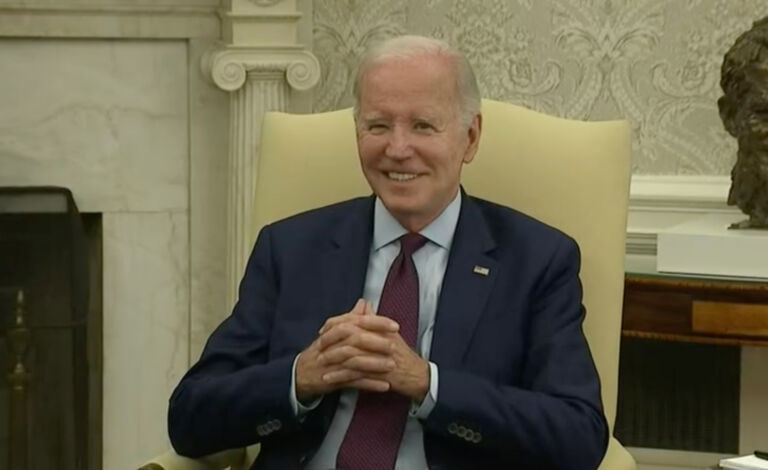The Left has offered several fallacies to explain our current inflation problem: the supply chain crisis, big businesses, and global causes chief among them. Their solutions are misguided given their failure to acknowledge the root cause.
And party politics keep the ruling class on the Left from proposing real answers.
Here are a few solutions offered by the Left:
- A Gas Tax Holiday
Senate Democrats seeking reelection proposed a federal gas tax holiday through December as a means to combat inflation and address their constituents’ concerns for rising costs at the pump.
As with most liberal policies, this sounds good only at face value. In reality, this tax holiday would reduce gas tax revenues by $20 billion, may even add to inflation “by boosting demand in an already over-stimulated economy”, and could benefit producers who keep some of the savings.
While consumers would feel minor ($2 per week by some estimates), temporary relief, such a measure will not dampen inflation. Our inflationary pressure is not the result of a lack of demand. A gas tax holiday would do nothing to address the underlying price increase in gasoline.
The gas tax holiday would deal a massive blow to the Federal Highway Trust Fund that pays for infrastructure throughout the country. And although the gas tax may soon be antiquated, it does follow a responsible, user-pays principle.
The political motivations for this solution are obvious: “And just to make the political games transparent, they want this to expire right after the midterms as soon as the next Congress is sworn in,” Senate Majority leader Mitch McConnell (R-KY) noted in a floor speech.
2. Build Back Better (BBB)
The Biden Administration initiated BBB to cement its climate goals and economic agenda and expand the social safety net. It is now being touted as an inflation fighter.
There is an argument that increasing childcare subsidies and universal pre-K would allow more parents to join the workforce. Such programs, however, would boost the quantity demand and only add to inflation.
Most of the bill is inflationary. In particular, the increased welfare elements like the child tax credit without work requirements discourage work and add to our economic woes.
Similarly, budget gimmicks hide the actual cost of the bill. According to the Congressional Budget Office, if the spending programs are made permanent, BBB’s cost would double to about $5 trillion and add $3 trillion to the national debt. The added debt would need to be financed largely by newly created money – the cause of price inflation in the first place.
3. Antitrust
Biden has considered penalizing big companies for inflation. His administration blamed industry concentration that has existed long before this year’s record inflation.
Attorney General Merrick Garland argued that “too many industries have become too consolidated over time.” Consistent with the all-too-common theme on the Left, he claimed that his department’s Antitrust Division is also understaffed and underfunded.
National Economic Council Director Brian Deese claimed that strengthened antitrust action “will deliver lower prices for Americans right away.”
But the government would only expand its power by weaponizing antitrust. If the Biden Administration gets its way, the government would be in the business of picking winners and losers. Worse, entrepreneurs and small businesses would be hurt as some may not be allowed to merge voluntarily or be acquired, a goal of many startups.
Government intervention will kill competition.
Accelerated antitrust action will fail to alleviate inflation because businesses are not responsible for inflation. Their price hikes are a response to inflation as they face rising costs of inputs.
As with the policies above that are now labeled “inflation fighters,” the Left’s desire to weaponize antitrust has nothing to do with inflation. Antibusiness action has long been on their agenda.
Real Solutions Require an Honest Look in The Mirror
These solutions should infuriate us. They make light of the real fiscal conundrum we are in. Worst of all, they do nothing to alleviate the price increases that harm low-income families most.
Some of the ongoing Covid “solutions” continue to push prices higher: the student loans repayment moratorium, for example, adds to price inflation as the Treasury must still fund this debt at the taxpayers’ expense. State budgets are overflowing with federal funds, yet the federal government continues to shell out more to fund states’ Medicaid matches, further driving up prices as the state spends more federal money elsewhere. Ending these policies will help, even if on the margins.
In the regulatory space, we have a long way to go. Mandatory work requirements for welfare payments present a good first step.
At the root of the problem, however, as my colleague addresses, is the overwhelming debt. A balanced budget may have allowed us to print less money. In fact, nations that solve their long-run balance sheets can afford to borrow in the short run. But our fiscal situation is dire. Our debt is larger than our GDP. Because of this debt, any borrowing is precarious.
Any disinflationary steps require a freeze in spending (and thus money printing) but also a serious recognition of our fiscal future.
Long-term growth will require getting out of debt and addressing the debt-inducing programs like Social Security, which with unfunded obligations of nearly $20 trillion will continue to come for more of your paycheck. Similarly, 12% of federal spending is on Medicare, another ballooning government program, with more than $33 trillion in unfunded liabilities.
Yes, it is undoubtedly more politically popular to promise more free programs. But at what cost?


